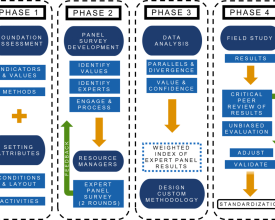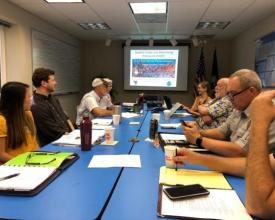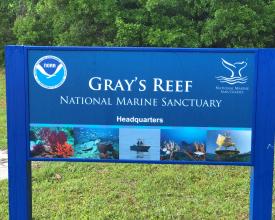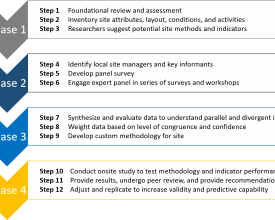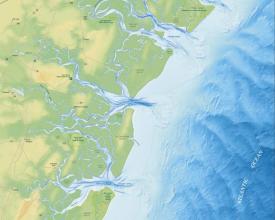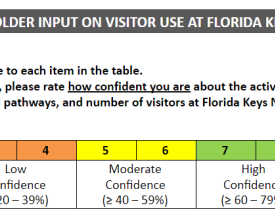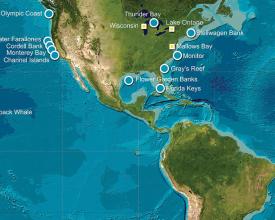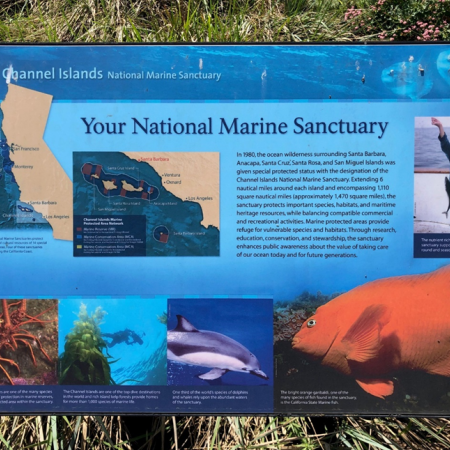
The National Marine Sanctuaries Visitor Counting Process: A Process to Inform Marine Protected Area Management & Community Development
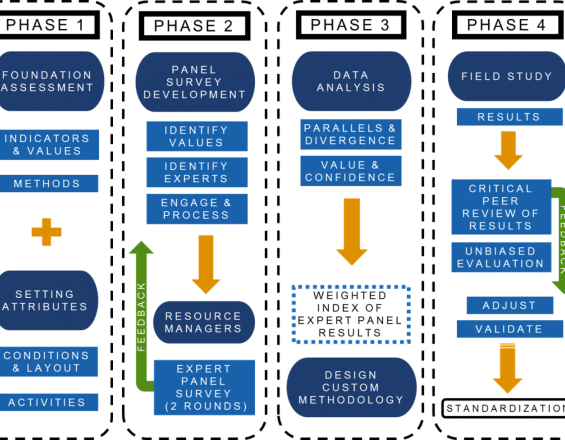
Through the National Marine Sanctuaries Visitor Counting Process (NMS-COUNT), marine protected area (MPA) resource managers gain valid and reliable data and methods to advance predictive capability and understanding of visitors. The NMS-COUNT process is an iterative framework that allows local management and stakeholders to add knowledge of visitor use at an NMS unit through each phase.
Building off the US Interagency Visitor Monitoring Framework, NMS-COUNT facilitates local input on visitation and communication with managers and researchers to develop and implement the most efficient methodology. Understanding visitor use can help MPA managers create better policies, leading to more satisfied visitors and healthier coastal ecosystems. Visitation data helps to efficiently maintain and manage local ecological, economic and social resources. NMS-COUNT helps resource managers adhere to limits of resilience within MPAs, leading to sustainable use and maintenance for future generations.
Contexte
Challenges addressed
Within the United States, over 172,481 square miles of marine and Great Lakes waters are designated as U.S. National Marine Sanctuaries. The NMS system consists of 14 marine protected areas and serves as a bridge to natural resource exploration, education, recreation, tourism, and many other ecosystem services. While various federal, state, and Coastal Treaty Tribe groups collaborate in the management of coastal and marine areas, there is little compatibility in methods for estimating visitation. Sanctuaries vary in size, may be located along shorelines or may lack a physical boundary when located offshore. This diversity of geographic locations results in unique challenges to counting visitors, especially when data collection must be cost-effective. Therefore, a blanket approach that does not incorporate site-specific details into sampling and estimating visitation would be unwise.
Emplacement
Traiter
Summary of the process
The NMS-COUNT process engages researchers, agency scientists and managers in an iterative process of four phases: 1) research and identification of visitor estimation methods applicable to a specific site, 2) expert panel to provide input on site-specific methods, use indicators (social, environmental, temporal, spatial intensity, etc.), and confidence levels, 3) development of a site-specific methodology and sampling plan, and 4) field testing and analysis.
In each phase, methods are analysed for confidence in producing visitor estimates that are efficient, valid, and reliable, and adapted via feedback throughout each successive iteration. Iterations between the three phases ultimately result in a scientific consensus on quantitative goals for measuring visitor use at an agreed upon level of confidence. While NMS-COUNT provides both value and technical input through its phases, the optimal use of the process will be context dependent and reliant on collaboration at the site and regional levels. A future goal is to apply NMS-COUNT across other marine protected areas and any area where tourism may be notably context dependent.
Building Blocks
The NMS-COUNT Iterative Framework: Phase 1
In Phase 1, researchers review the literature for a comprehensive understanding of methods in visitor sampling, estimation, and monitoring in a range of settings. From this research, potential methods and the types of data they produce are identified, as well as the advantages and disadvantages of using each method at different scales. To examine which methods and indicators of visitation are most effective in a chosen NMS, all site attributes, visitor activities, and conditions (social, biophysical, regulatory, spatial, and temporal, etc.) of the sanctuary are inventoried. Researchers then determine which methods are potentially appropriate for that particular sanctuary, at a range of confidence levels (low to high). Gray’s Reef National Marine Sanctuary will be used as an example to better understand NMS-COUNT throughout this solution.
Enabling factors
A high degree of interaction from researchers is required in this phase. During Phase 1, researchers gathered and compiled materials to understand the site layout, attributes, conditions and reported recreation activities. Researchers must conduct a foundational assessment to fully understand the indicators and standards set for the management of the protected area, the values associated with the setting, and any setting attributes that are unique that would not allow for replicating to other settings.
Lesson learned
Two primary activities at Gray's Reef were identified - diving and fishing, with the primary activity being recreational fishing. This helps inform the NMS-COUNT process with focal data sources that identify volume, frequency and impact of this dominant visitation type. Some existing data sources inform the process, such as those visitation counts captured by other survey methods (e.g. law enforcement patrols, automated vessel identification systems, etc.). Beyond existing data sources, the potential visitor estimation methods examined for this entirely offshore protected area setting were boat-launched drones, fixed-wing aircraft, and on-site surveying.
The NMS-COUNT Iterative Framework: Phase 2
Phase 2 brings together various agency managers, local stakeholders, and researchers to address a set of management objectives and associated monitoring needs. In this collaborative process, all stakeholders contribute their knowledge and perspectives on legal mandates, policies and factors that influence visitation and use within a specific sanctuary. Managers and local informants participate in a series of surveys and workshops that progress from a more broadly-based questionnaire to one with more specific questions based upon prior feedback. The expert panel discusses visitor trends and challenges specific to monitoring visitation at their site. The results of each iterative survey and workshop provide detailed insight into the current state of knowledge on visitation and level of confidence in the ways this information has been obtained.
Enabling factors
Phase 2 requires full engagement between the local managers and researchers. When managers engage local stakeholders and inform them of the process, the information provided to researchers is more comprehensive. This portion of the process relies on interpersonal relationship development for researchers and stakeholders alike. Development of such working relationships via workshop contact and other interactions helps establish a foundation of trust and cooperation for the NMS-COUNT process to proceed upon.
Lesson learned
In Phase 2, the research team engaged managers and stakeholders to better understand current visitation status at the sanctuary. Working with the NOAA Office of NMS, researchers were given access to contact 32 local resource managers and stakeholders with institutional knowledge about the site. This allowed the research team to develop a panel survey and engage the local stakeholders in a panel forum. All stakeholders were sent an initial questionnaire asking for their insights on visitation to the sanctuary in general. Three stakeholders responded to the questionnaire, providing general feedback on visitor activities, temporal and spatial patterns of use, pathways to and through the Sanctuary, and current visitor counting status. Based on this feedback, a second round of questionnaires were refined for use at the panel workshop. The in-person workshop featured detailed discussions of identified challenges to visitation monitoring at Gray’s Reef NMS. It also allowed detailed discussion of existing data availability for initial visitation monitoring strategies and modeling efforts.
The NMS-COUNT Iterative Framework: Phase 3
In Phase 3, data from expert panel input are analyzed and gaps are identified. A methodology is designed specific to the sanctuary based on this analysis. This methodology is customized to each specific MPA setting, based upon data gathered through Phases 1 and 2, as well as feedback from managers and stakeholders to assess the confidence associated with specific sampling techniques.
Enabling factors
Similar to Phase 1, the greatest burden in Phase 3 is on the researcher. An appropriate methodology allows researchers to identify limits using existing data and illustrate gaps that hinder managers from fully understanding visitor use. A combination of expert judgment and feedback allows researchers to determine the utility of specific sampling techniques. Modeling of existing data sources within a framework that assigns confidence to each source helps create a starting point for visitation numbers that can be built upon in later iterations.
Lesson learned
In Phase 3, researchers compiled the data shared by all the various stakeholders. For Gray’s Reef, data were synthesized and evaluated to understand the correlation in the confidence in the data by stakeholders. Using a 10-point confidence scale, stakeholder perceptions of their confidence in the data were tabulated. The panel study revealed that data on visitor counts were being collected by multiple agencies (i.e., NOAA, U.S. Coast Guard, GADNR) and sources including satellite, boat radar, smart-buoy, on-site patrols, and underwater hydrophones. This breadth of data was only realized by following the NMS-COUNT process, as the data emerged during the second and third phases of the process. The NMS-COUNT process helped all of those involved in managing visitation to collaborate and understand the types of data being collected across multiple agencies. The process also facilitated the integration of multiple data sources to provide a more comprehensive understanding of visitation to the Sanctuary.
The NMS-COUNT Iterative Framework: Phase 4
In Phase 4, a field study tests the methodology and performance of measures. The results of the study and all phases will be used to validate and standardize methods, and to advance development of visitation indicators and models. Depending on the customized suite of methods developed in Phase 3, Phase 4 could contain a multitude of techniques that involve both on-site data collection via surveys and observations as well as data mining from existing sources or other agency activities.
Enabling factors
Phase 4 requires synthesis of data from multiple agencies and stakeholders. This integration is critical to the success of the NMS-COUNT process. A full understanding of data analysis methods and data synthesis is required. This Phase is also enabled by collaborative planning at the site level to determine proper spatial and temporal characteristics of sampling.
Lesson learned
Phase 4 represents the ongoing data collection effort to fill in any gaps noted in the first three phases. One of the most critical gaps uncovered via NMS-COUNT in the existing visitor count data is the frequency of sampling or when and how often sampling occurs. Because of this gap, the research team will place interviewers on two dive boats to record observations of visitor counts in the sanctuary and to conduct interviews with the touring participants. There will also be several roving intercept surveyors which collect data from visitors as they leave the shoreline or return from offshore for visitor activities. Existing data streams will continue to inform the visitation estimates, with models that account for spatial and temporal changes detected by on-site sampling. Following the data collection effort, the results will be shared with academic and agency peers. Resource managers will continue to monitor and adjust use as needed to meet the requirements of the agency or other management plans.
Impacts
The NMS-COUNT process provides value and technical input through its phases, the optimal use of the process will be context dependent and reliant on collaboration at the site and regional levels. A future goal is to apply NMS-COUNT across other marine protected areas and any area where tourism may be notably context dependent. Areas where estimation of visitation is not as simple as counting within a captive area (e.g. gate counts at a park) will benefit from the addition of NMS-COUNT steps to guide such computations. The process is designed to be used by both the academic community and resource managers, so the process can be replicated and extended over time. It also promotes management of aquatic protected areas in an adaptive framework, as expert panel stakeholders inform value and technical choices that are assessed through pilot studies and data analyses. The NMS-COUNT process helps understand the foundational visitor dynamics which lead to economic, social and environmental impacts within and surrounding MPAs. Economic impacts are directly linked to visitor expenditures, while social and environmental impacts are linked to visitor experience and activity. A clear understanding of visitation through NMS-COUNT allows easier identification of these linkages among impacts.
Beneficiaries
The NMS-COUNT process benefits natural resource managers in areas that do not afford traditional sampling of visitors. Beneficiaries also include visitors who use sanctuaries, and researchers who measure economic, ecological, and social impacts.
Sustainable Development Goals
Story

Protected area management sits along a delicate axis of conservation and accessibility. In one sense, protected areas are designated as such for a reason, they often contain natural beauty, vibrant ecosystems, and many other desirable features worthy of protection. It is because of these remarkable features that visitors have desire to experience such wonders.
This level of interest and admiration helps develop the critical need and challenge of gaining knowledge concerning visitation. Tourism in protected areas can cause tension between conservation and use. MPAs represent a special challenge relating to the common absence of visual and physical borders. Additionally, marine ecosystems, like coral reefs, can react sensitively to changes in environmental conditions, some of which may be modified by effects of visitation activities. The essential part of the NMS-COUNT story seeks to create robust understanding of visitation in challenging areas that allows the management of such areas to seek a proper balance between protection and use.
The NMS-COUNT process offers a solution to numerous challenges within the story of MPAs, built upon the best available science and localized input. The NMS-COUNT process follows the Interagency Visitor Use Management Framework (IVUMF), which provides a unified, collaborative approach to develop strategies for providing access to recreation, while protecting resources and managing visitor use. NMS-COUNT also follows the Drivers-Pressures-State-Ecosystem Services-Response (DPSER) model, which integrates human dimensions and biophysical information into a framework that illustrates the complex interactions of human dimensions with ecosystem services. These interactions are involved in management trade-offs between the state of the ecosystem and quality of ecosystem services, a crucial part of any MPA story. The NMS-COUNT process engages academics, scientists and managers in an iterative process of four phases: 1 research and identification of visitor estimation methods applicable to a specific site, 2) expert panel to provide input on site-specific methods, use indicators (social, environmental, spatiotemporal, etc.), and confidence levels, 3) development of a site-specific methodology and sampling plan, and 4) field testing and analysis. Iterations and replication of the process provides a conceptual way of thinking and learning about tourism dynamics, even if application of the process is unique to individual sites.
